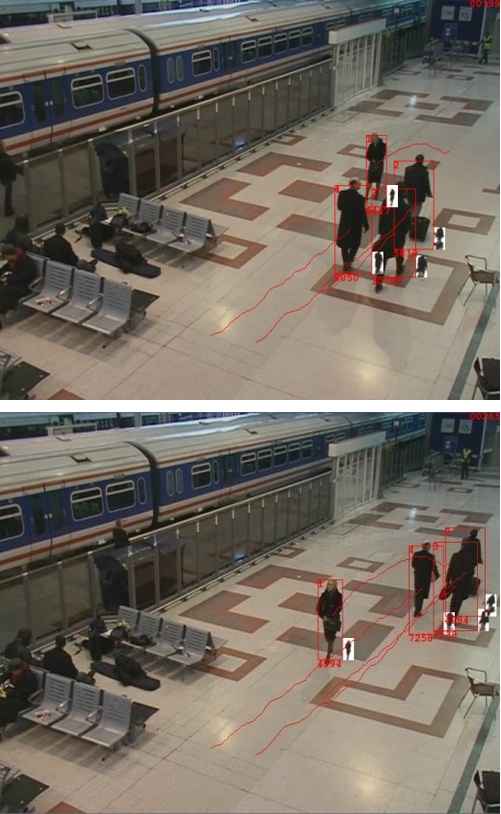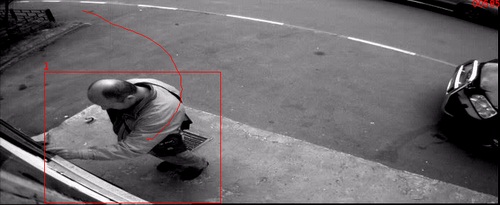
Borisov Alexandr
Faculty: Computer Science and Technology
Department: Computer engineering
Speciality: Computer systems and networks
Theme of master's work:
Tracking and managing the geometrical shape of the regions of interest in video sequences
Scientific adviser: Samoshchenko Alexander
Abstract
Introduction
Relevance of the topic
The scientific significance of the work
The practical value of the work
Object and subject of research
A review of research on the topic
Index approach and its application to the problem of tracking moving objects
Morphological analysis of dynamic scenes in the video sequence
The classical approach to the detection of objects
Segmentation of the object
Hybrid system of maintenance
Conclusion
References
Regions of interest in video sequences
Introduction
Nowadays with the development of the Internet and digital technology, many people use various devices such as cameras and even mobile phones to memorializing their favorite moments of their lives in photographs or video recordings. However, it can also be and films or, for example, downloaded from the Internet video. But sometimes the quality of the video stream is poor. For example, video, which was download long ago, when there was no such advanced equipment can include some so-called artifacts. And, say, the viewer must consider a figure - a region of interest - on the screen in this video. This video will be subject to filtering to remove artifacts. But the decline number of artefacts depends of bandwidth transmission channel. So how to pass better through the channel with low bit rate, then it is here and there need to allocate the region of interest sequence, which will be subject to filtering, while the rest of the image (eg, background) will remain low bit rate and less quality representation.
Relevance of the topic
The problem of finding the region of interest in the video sequence is very urgent, because it can independently handle the necessary parts of the video sequence. This allows skontsentrorovatsya on substantive material objects and ignore the quality of non-essential, such as, for example, background.
The scientific significance of the work
Scientific significance of this work is to develop improved methods of finding and controlling the shape of regions of interest in video sequences.
The practical value of the work
In carrying out the work after the simulation with an improved method of controlling the shape of the region of interest in video sequences expected to get a video with a smaller size than, for example, a file, which also applies to find the region of interest sequence, but there is no implementation of the management of its form.
Object and subject of research
The object of research is a sequence of video frames containing regions with different informative value. The subject of research is the search algorithm and controlling the shape of regions of interest.
A review of research on the topic
Subject Search regions of interest in the video sequence is found in the works for graduate and staff DonNTU. Also present work on segmentation, finding certain objects in the video. Find a job you can use the "References" section.
At this point in the interent, and not only represented a large number of papers on the topic of finding regions of interest in video sequences. In these works dominated algorithms for solving a specific problem, ie, known directly to the initial information.
Index approach and its application to the problem of tracking moving objects
The problem of finding an appropriate benchmark is the actual problem, which finds practical application in many problems in computer vision and, in particular, in video surveillance.
Used algorithm for solving the problem of finding an appropriate benchmark is constructed based on the concept of an index memory, proposed by A. Mikhailov. There are many algorithms for solving the problem of finding an appropriate standard. For example, the proposed modification of the Full Search Approach associated with the review of previous patterns. Traditionally, the performance of algorithms for solving the problem of finding appropriate standard is compared with Full Search approach.
Also, existing methods of reducing the dimensionality of data, such as hashing or encryption, among which are the wavelet method can be considered as ways of solving the problem of finding signs. for example, by using wavelet and recognize the resulting feature vector with an index of memory.
Solution to the problem of finding an appropriate benchmark index method.
Let us remember the X template for what each pattern is characterized by a vector of Y properties. Then for a given property y {xy} z means the set of stored templates which znacheniesvoyctva y equals z [1].
Suppose we have the object in z (z - a vector of properties). Then the problem of finding an appropriate reference is solved as follows:

If the distribution of the stored template on the values of attributes uniformly with a width of Z, then the savings calculations in comparison with Full Search approach is in Z time.
Morphological analysis of dynamic scenes in the video sequence
In the standard morphological methods we consider the set V of all images obtained from the scene under all possible conditions of observation, and the rule of recognition scenes (a scene or object) to bring the image of f consists in verifying his membership to this set: f є V means that the image f can be obtained from a given scene, under certain conditions of registration. If the image is considered as an element of a metric space, then check the condition f є V can be solved in terms of projections of P f V image f to V. The projection of P f V is defined as the image of the set V, the closest to f. Equality f P f = V is equivalent to inclusion f є V. The successful application of morphological methods due existence of the constructive rules for calculating the projection of P f V for those situations when the scene in different images of the V presents the water and the same angle. Set V (or PV opeeratsiya projecting upon him) called the "form of the image scene"
In constructing the projector PV (t) used a mathematical model sequences, taking into account that changes in lighting conditions may not change significantly, and fragments of view, depicting the moving scene objects, can not significantly shift during the time between two frames.
Based on the algorithm for computing the projector PV (t) developed methods analysis of dynamic scenes on video sequences, in particular - the methods for tracking moving and changing the subject to changing background.
For tracking such object sequentially following tasks:
1. Allocation of new objects by selecting the current difference image obtained from an image background.
2. The definition of "areas of interest" based on an analysis of the size of new
objects and the speed of their movement.
3. Search for new location of the object.
4. Updating the object's shape.
5. Updating the shape of the background.
The classical approach to the detection of objects
The general algorithmic approach to the detection of moving objects is to analyze the differences between the current frame and background model.
Simplistically, this approach is called the subtraction of the background (background subtraction). Pixel belonging to an object (or background) is determined
based on the deviation value (brightness) pixel in the current frame of a statistical model to estimate the background. There are many methods
modeling the background image. The most common methods for running Gaussian average (running Gaussian average) and Gaussian
mixture (mixture of Gaussians):
1. Running average method has been successfully operating in a sterile environment where the background remains stationary.
In the case of a global volatile background, for example, movement of forest, bush and water, unimodal model does not allow efficient
to detect foreign objects
2. Method gassovskoy mixture is multimodal and can more accurately describe the statistics of variable background.
However, the simulation of individual pixels, rather than their patterns, it does not provide a noticeable increase in accuracy of detection.
Moreover, the method of Gaussian mixture is substantially more resource intensive than running average, and usually does not fit into the framework
computing power embedded processor.
At the stage of segmentation, the individual pixels are extracted from the background, come together in regions with morphological operations. Regions that match the size and shape, can be considered targets. As a rule, the phase morphology analysis of the largest computational cost. The complexity of the analysis increases nonlinearly with the increase in the area of regions and their number.
Segmentation of the object
The mask of the object, calculated segmentatorom useful for calculating the characteristics of the object for his support and for more accurate modeling of the background.
Are considerably disadvantage of the classical approach is the high resource intensity of morphological operations on the stage of defining mask regions.
Multiscale approach allows us to significantly improve the computational efficiency analytics by limiting the depth segmentation
and / or use of the model object's shape. At the same dimensions of the detected objects, which can vary considerably in the field of view camera
will not significantly affect the computational cost of the algorithm.
During the back-propagation signal, generated multiscale mask region. Segmentation is performed from coarse to detailed mask
and the process can be stopped after reaching the desired level of detail or after the exhaustion of the quota of computing resources. Input data
are the mask from the previous region, the difference between the signs of the current frame and background model on the current layer, as well as an optional model detected
object. Output data is a mask of the region on the current layer. At each pixel is clarifying mask based on the method of binding in the pyramid.
Fig. 1 shows the results of multiscale segmentatora-based linking method in a pyramid on several grounds: the top - the original frame,
processed video analytics with the trajectory followed by the person; below - four layer mask segmentation. Masks contain some minor errors in the form of
points and imprecise boundaries, due to computational optimization of morphological operators [2].
 Figure 1 - Multiscale segmentation: original image and the mask with increasing detail
Figure 1 - Multiscale segmentation: original image and the mask with increasing detail
Hybrid system maintenance
Algorithms for tracking (tracing) provide a trajectory of objects for more accurate recognition and assessment of dynamic features.
In classical implementations, integrated analytics popular following algorithmic approaches:
1. The union of the regions identified by the detector in time for the set of consecutive frames to calculate the desired trajectory object. This is the easiest method in terms of implementation. Its main drawback is that the error detector regions lead to undesirable discontinuities of the trajectory. Likewise, the method can not maintain the objects in a group and go astray when a false regions. In slow motion or stop objects "grow into" in the background, and the tracking algorithm loses the target.
2. Correlation methods involves the construction of a statistical model, not only the background, but the object. The degree of similarity between objects in different points of the neighborhood object to determine its most probable position. The advantage of this approach by comparing with the first is opportunity to support a partially overlapping objects in the group, as well as a more stable operation with low-contrast or slow objects. The main disadvantage - significantly higher resource consumption. Correlation methods are ineffective at low frame rates and strong variability follows an object.
3. Optical flow based on the assumption that the coverage is constant, and the shape and texture of the background and accompanied by an object are not changed. The method of optical flow from a computational point is more effective than the correlation method, but inferior to him in stability in the face of noise and variability of the object.
 Figure 2 - Support of a volatile object by using the algorithm of binding regions
Figure 2 - Support of a volatile object by using the algorithm of binding regions
Consider the hybrid method. On the one hand, time series analysis found regions can effectively accompany isolated objects, including those that significantly change the shape (Fig. 2). On the other hand, the correlation method allows us to maintain the objects in the group (Fig. 3) or when the detector is not sensitive enough to locate the regions.
Combining the results of the algorithms is done by selecting the most likely estimate of the object. For such approaches as a basis for evaluation is the contrast of the region on the background and significance of the correlation characteristics of the object area. It is prohibited in the mutual overlapping of objects tracked.
Multiscale representation of the mask and attributes of the object to significantly increase the computational efficiency of the correlation algorithm and to increase search radius, that is, solvesthe problem of the aperture [2].
 Figure 3 - Individual support facilities at the time of the meeting (above) and after the meeting (below) using the correlation algorithm. Piece of video from PETS
Figure 3 - Individual support facilities at the time of the meeting (above) and after the meeting (below) using the correlation algorithm. Piece of video from PETS
Conclusion
From the above material shows that there are many approaches to finding regions of interest in video sequences and its processing. Although the set of methods is not exhaustive, they are typical representatives of the technology selection of regions of interest sequences.
References
1.Техническое зрение в системах управления 2011 (тезисы докладов) [Электронный ресурс] - http://tvcs2011.technicalvision.ru/docs/Abstracts2011.pdf
2.Птицын Н. - Встроенная видеоаналитика для детектирования и сопровождения объектов при помощи многомасштабных признаков (ГрафиКон 2010) [Электронный ресурс] - http://synesis.ru/ru/surveillance/articles/multiscale-va
3.Журавель И. М. - Основные процедуры захвата изображений [Электронный ресурс] - http://rrc.dgu.ru/res/matlab/imageacquis/book1/2.html
4.Субботин С.А., Бойченко К.Ю. - Автоматическая система обнаружения и распознавания автотранспортных средств на изображении [Электронный ресурс] - http://www.swsys.ru/index.php?page=article&id=2448
5.Назиров Р.Р., Грищин В.А. - Техническое зрение в система управления 2011 [Электронный ресурс] - http://tvcs2011.technicalvision.ru/docs/Abstracts2011.pdf
6.Обзор форматов качества видео [Электронный ресурс] - http://en.wikipedia.org/wiki/Video_quality
7.Востров Г.М., Монастырский О.В., Полторак Д.М. - Анализ потерь при компрессии видеопоследовательностей и методов их устранения. [Электронный ресурс] - http://www.library.ospu.odessa.ua/online/periodic/opu_2004_1(21)/4/4-8.pdf
8.Обзор характеристик потокового видео [Электронный ресурс] - http://en.wikipedia.org/wiki/Video#Characteristics_of_video_streams
9.Фаворская М.Н. - Модели и методы распознавания динамических образов на сонове пространственно-временного анализа последовательностей изображений [Электронный ресурс] - http://research.sfu-kras.ru/sites/research.sfu-kras.ru/files/Favorskaya_Favorskaya__11.pdf
10.Савченко Д.А. - Исследование методов сегментации изображений [Электронный ресурс] - http://masters.donntu.ru/2010/fknt/savchenko/diss/index.htm



